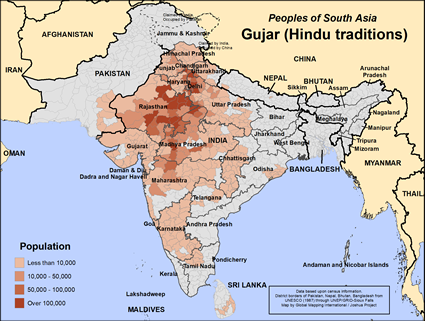Gujar (Hindu traditions) in India

Photo Source:
Anonymous
|

Map Source:
People Group Location: Omid. Other geography / data: GMI. Map Design: Joshua Project
|
| People Name: | Gujar (Hindu traditions) |
| Country: | India |
| 10/40 Window: | Yes |
| Population: | 7,306,000 |
| World Population: | 7,593,000 |
| Primary Language: | Hindi |
| Primary Religion: | Hinduism |
| Christian Adherents: | 0.00 % |
| Evangelicals: | 0.00 % |
| Scripture: | Complete Bible |
| Ministry Resources: | Yes |
| Jesus Film: | Yes |
| Audio Recordings: | Yes |
| People Cluster: | South Asia Hindu - other |
| Affinity Bloc: | South Asian Peoples |
| Progress Level: |
|
Introduction / History
The Gujar are comprised of three very closely related people groups that are known collectively as the Gujar Rajasthani. They are from the Kshatriya (military) caste.
They are located in Afghanistan, Pakistan, and several states in northeastern India (Himachal, Madhya Pradesh, Uttar Pradesh, Jammu, Kashmir, and Rajasthan). In addition, the Gujarat district of western India is named after the historic Gujar peoples.
The Gurjar Prathihar Dynasty ruled North India for 331 years. King Mihir Bhoja was a powerful king. The Gurjar empire fell in 1018.
Hindu Gujars now live in most of India s northern states: Delhi, Rajasthan, Haryana, Uttaranchal, Odisha and the central state of Madhya Pradesh.
What Are Their Lives Like?
Today, most of the Gujar living in India live as law-abiding shepherds and farmers. Unfortunately, they are still belittled by those of higher castes (social classes) and often labeled as thieves and vagrants.
The Gujar living in the mountain forests of northeastern India raise buffalo. Unfortunately, the Indian government has imposed regulations on the number of buffalo one family can keep, and on how long they can live in the forests. This has been distressing for the Gujar since this is their main source of income. For this reason, these nomads are constantly searching for new pastures for their herds.
Gujar nomads who live in the state of Jammu and Kashmir are often cheated by the middlemen, who take their agricultural products to the city markets and sell them as their own.
The Gujar castes are broadly divided along religious and geographic lines into two groups: the Muslim Gujar and the Hindu Gujar. The Muslims are seasonal nomads who live in windowless, one-room houses during sedentary growing seasons; whereas the Hindus are settled farmers who live in the same place all year.
The Gujar are divided into hundreds of clans. Their societies are patrilineal, which means that inheritances are passed down through the males. Marriages are usually arranged by the parents, and a bride price of either cash or buffalo is paid to the girl's family. They are permitted to marry outside their clans, and young couples generally live near the grooms' parents.
All three Gujar groups speak Gujari, an Indo-Aryan language. This common factor has helped to identify them as a distinct sub-group. The Gujar of Afghanistan also speak Pashto and/or Dari, which are Persian languages (and are spoken by three-quarters of the Afghani population).
What Are Their Beliefs?
A larger percentage of the Gujar are Hindu, but there is also a significant number of Muslims among the Gujar, as well as a smaller number of Sikhs.
Because the Muslim Gujar share Hindu customs, they are not generally accepted by other Muslims. Nevertheless, in their desire for a unified front against the Hindus, the Muslim Kashmiri have agreed to accept the nomadic Gujar Muslims who recently entered Jammu and Kashmir.
What Are Their Needs?
The Gujar people in India have few if any chances to hear of the one who offers life to the full. How will they hear?
Prayer Points
Ask the Lord to send forth laborers into India, Pakistan and Afghanistan to share Christ with the Gujar.
Pray that God will encourage the small number of Gujar believers and give them a vision to reach their own people.
Ask the Holy Spirit to soften the hearts of the Gujar so that they will be receptive to the gospel.